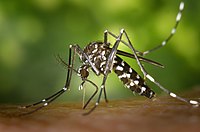
Photo from wikipedia
BACKGROUND Public community engagement is crucial for mosquito surveillance programs. To support community participation, one of the approaches is assisting the public in recognizing the mosquitoes that carry pathogens. Therefore,… Click to show full abstract
BACKGROUND Public community engagement is crucial for mosquito surveillance programs. To support community participation, one of the approaches is assisting the public in recognizing the mosquitoes that carry pathogens. Therefore, this study aims to build an automatic recognition system to identify mosquitos at the public community level. We construct a customized image dataset consisting of three mosquito species in either damaged or un-damaged body conditions. To distinguish the mosquito in harsh conditions, we explore two state-of-the-art deep learning (DL) architectures: (1) a freezing convolutional base, with partial trainable weights, and (2) training the entire model with most of the trainable weights. We project a weighted feature map on different layers of the model to visualize the morphological region used by the model in classification and compared it with the morphological key used by the expert. RESULT It was found that the model with architecture two and the Adam optimizer achieves at least 98% accuracy in mosquito and conditions identification and when implemented on an independent dataset, the Xception model generalizes the best result with an accuracy of 0.7775 and 0.795 precision. Moreover, most of the morphological regions used by the model are able to match those of the human expert. CONCLUSION We report a customized DL model for performing pest mosquito taxonomy identification, and through visualization, some regions using computers to discriminate mosquito species could be adopted later in systematic identification.
Journal Title: Pest management science
Year Published: 2022
Link to full text (if available)
Share on Social Media: Sign Up to like & get
recommendations!